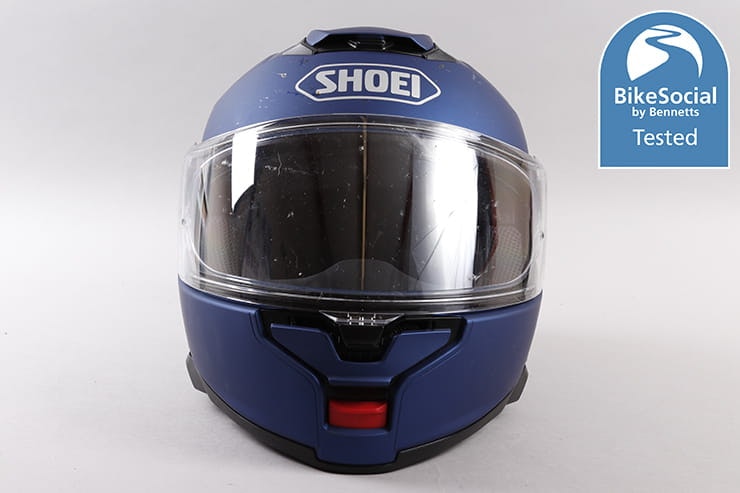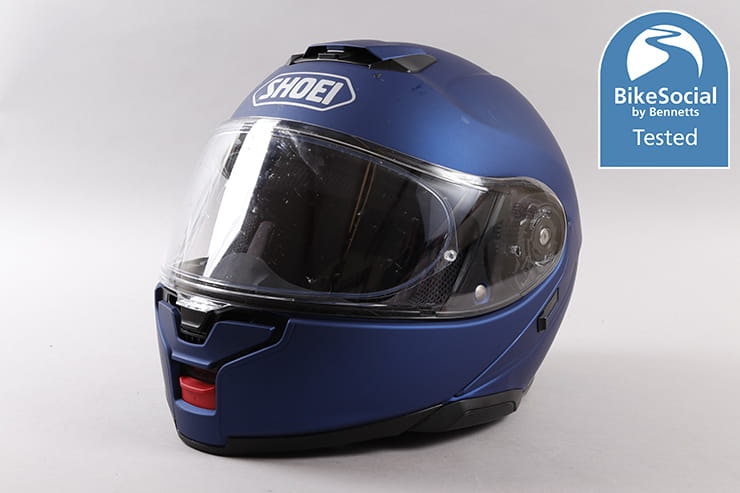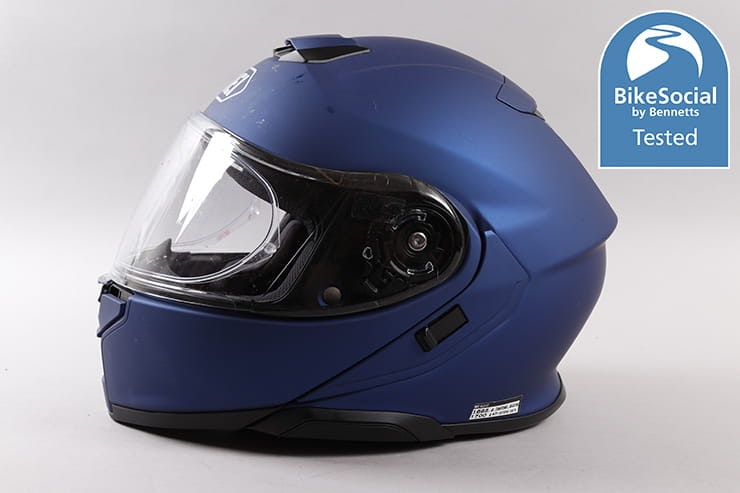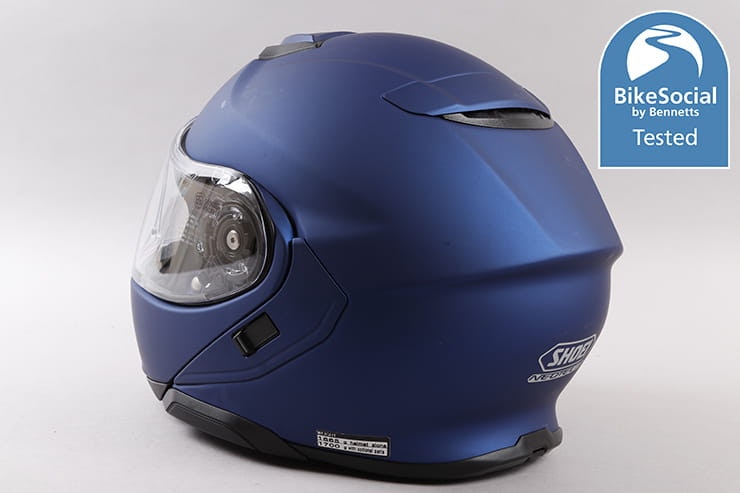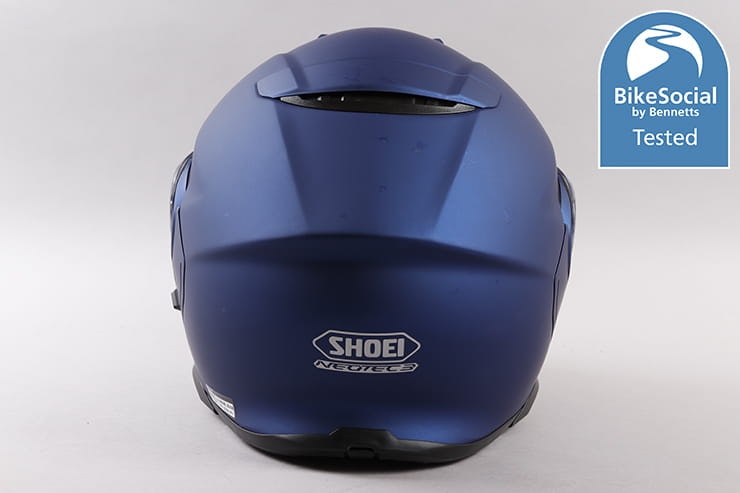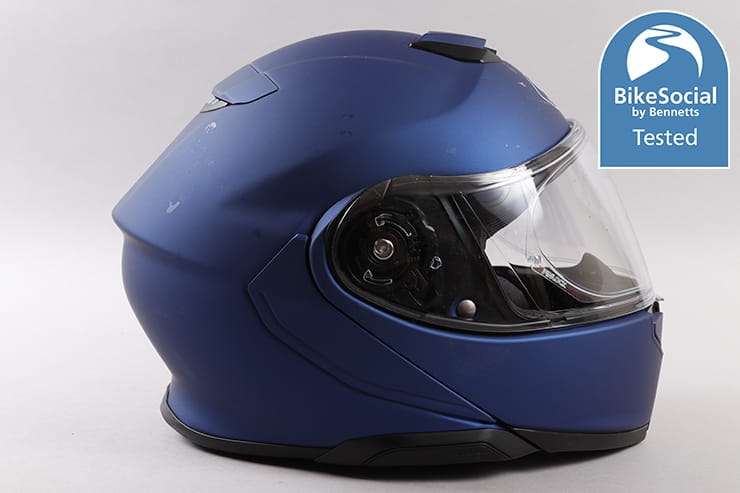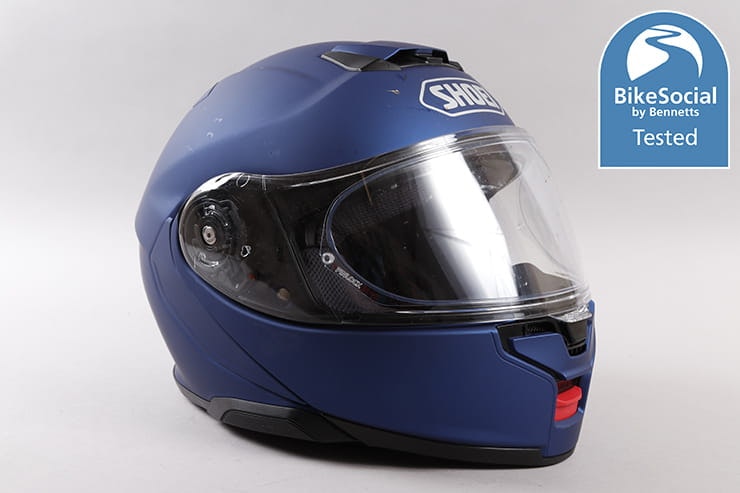Shoei Neotec 3 review | Bench-mark modular flip-front tested
By John Milbank
Consumer Editor of Bennetts BikeSocial
01.09.2023
Date reviewed: August 2023 | Tested by: John Milbank | Price: From £589.99 | www.shoeiassured.co.uk
The Shoei Neotec 3 on review here is one of the most important motorcycle helmet launches of the year as this flip-front lid has long been the benchmark for touring riders, not to mention couriers and the emergency services.
Bennetts BikeSocial has an enviable reputation for the most in-depth and honest reviews of motorcycle kit, and it’s very important to us that we maintain that. While I was fortunate enough to get hold of a full production version of the Neotec 3 four weeks before its release having signed a strict non-disclosure agreement, the test – as always – remains entirely independent and unbiased.
As we finally release this review, I’ve ridden around 700 miles in the Shoei Neotec 3 on a 2019 BMW R1250GS, a 2001 Honda VFR800 and a 1999 Kawasaki ZX-6R, to find out if the changes made are truly improvements…
Better in almost every way than the Neotec II
Excellent build-quality and comfort
Extremely practical for road riders
Pinlock isn't wide enough
Very heavy extended rain sees a little water get into top vent, but it’s channelled away
Shame the top vent doesn’t have a bug mesh
Outer shell
As you’d expect of a top-of-the-range premium motorcycle helmet like the Shoei Neotec 3, the finish on the outer shell is excellent. Construction remains the company’s Advanced Integrated Matrix (AIM), which is a five-layer laminate of glass and organic fibres for high strength and rigidity.
I have the matt blue metallic finish, which retails at £30 more than the entry-level £589.99 plain black or white options. Full graphics cost £679.00, so across the range the Neotec 3 has seen a price rise of £30 over the Neotec II.
This new helmet is of course certified to the tougher ECE22.06 standard, which means it’s proven to offer increased protection in a greater variety of tests than an ECE22.05-certified lid.
22.05 saw helmets dropped onto a flat and a kerb anvil at 16.8 mph with a weighted head form inside. That’s still in 22.06, but now there are an extra 12 impact points tested, with high and low speed tests too. There’s also a new oblique test, to ensure helmets do all they can to protect the brain from the twisting forces that can occur if your lid hits a surface at an angle.
Dual homologation is a pre-requisite of ECE22.06, so it should come as no surprise that, like the Neotec II before it, the new Shoei can safely be worn in the open or closed position while riding as the chin guard stays locked in place when fully up. Cleverly, Shoei hasn’t had to include any form of manual lock to achieve this, so unlike the AGV Tour Modular or Schuberth C5, you don’t need to faff with any fiddly buttons. Not that most people bother anyway.
The Shoei Neotec 3 uses a medium-size shell for sizes XS, S and M, a single large shell for size L and an extra-large shell for sizes XL and XXL.
The beauty of a flip-front – or modular – helmet is of course that you can pop it open when filling with fuel, to talk to mates or ask directions, or of course if you want the full wind-blast of an open-face lid. My phone’s face-recognition works with the chin-bar up too, so I can unlock my phone without having to take my gloves off – great in petrol stations!
In this case though, it is worth noting that if your head is in the wind, higher speeds will cause significant drag as the chin-bar acts as a sail. If you want to ride with the chin bar open a lot, consider a ‘flip-over’ lid like Shark Evo or LS2 Advant, for example.
Importantly, the chin section locks down easily and positively when wearing the Neotec 3, even using one hand while riding. Unlike some of its competition though, the Shoei doesn’t ‘remember’ where the visor was set when you open the chin section, so even if the visor’s open, when you close the front of the lid back down the visor will be closed (but not locked) too.
The ECE22.06-certified Neotec 3 scores 5/5 in Sharp testing, though the chin guard stayed securely locked during 93% of the tests.
Why does the Shoei Neotec 3 not have a lock?
When I was asked by a rider why the Shoei Neotec 3 doesn't have a locking tab for the chin-bar when it's up, I looked into the requirements for ECE22.06 certification and figured that Shoei must designed the Neotec 3 to hold itself open, without the need of a lock. But with some brands fitting locks even to flip-over helmets, I asked if anyone at Shoei could give me some more information...
"We acknowledge that many helmet manufacturers incorporate a red locking mechanism that secures the face cover in the open position," said Shigenobu Onodera, General Manager of Quality Control at Shoei in Japan. "However... the locking mechanism of the Neotec 3 is designed to meet the safety requirements of ECE R22.06 through the structure of the helmet itself without an additional control/actuating device as seen in the other brands. As a result, we have determined that there is no component that requires identification in red, as specified in section 6.12 of the regulation.
"This determination is consistent with the regulation, as evidenced by the fact that the Neotec 3 was homologated under UN/ECE Regulation No.22.06 (Homologation No. 0660025) by the Belgium Ministry of Transportation on April 4, 2023."
Weight
Weight is something worried about by far too many buyers, which of course isn’t helped by it being a great sales pitch in some cases. Watch for being handed the lid you’re being steered towards with two hands, then the heavier alternative while you’re holding the other, so you have to take it in one hand.
There’s no denying that the Neotec 3 – at a measured 1,732g in medium – is heavier than the Schuberth C5 at 1,695g and the AGV Tour Modular at 1,703g, but I defy anyone to actually be able to tell any difference when they’re riding. Even compared to the 1,350g Scorpion EXO-1400 Carbon full-face, while you can obviously tell the difference when comparing in the hands, you’d have to have a very strange neck to worry about it when it’s on your head.
What matters is aerodynamics. Despite the Shoei Neotec 3 being a helmet that will most likely be worn on bikes with a decent-sized fairing or screen, up in the wind there’s very little drag. Compared to the Neotec II, I’d say that while the new model doesn’t feel as invisible as the Arai RX-7V Evo, for instance, only when turning the head for a life-saver while fully in the wind at high motorway speeds is there any noticeable (but far from bothersome) feeling of drag.
I’d also say that the new model has less drag when turned to the side than the previous one, which just feels a little more grabby at high speed with no wind protection.
Ventilation
Like the Neotec II before it, the Shoei Neotec 3 has a chin vent (though now it’s two stages and closed, rather than just open or closed), a two stage and closed top vent feeding two ports, and an always-open exhaust with two ports fed by a single hole in the middle rear of the expanded polystyrene (EPS) liner, as well as three smaller ones on either side of the top of the head.
The top vent of the new Neotec 3 gives a similar, impressive airflow to the top of the head even with the screen up on the R1250GS, but it’s now much easier to operate than on the old model, which had no real lip to push on, and got increasingly stiff over time.
The chin vent’s two open positions feed up across the visor and to the brow, and it’s easy to operate with gloved hands either using the ridge in the middle, or either side of the inlet covers.
There’s a new bug-guard mesh built into the chin vents, and a supplied tool makes it easy to remove for cleaning if necessary. It’s a shame there’s no guard on the top vent, and that it’s not possible to disassemble it for cleaning like the Schuberth C5.
A nose-guard is also supplied, which fits into the top of the chin section and helps keep your breath from the visor while diverting some of the air to your face, not just all up across the visor. It’s a clever design, though on a bike with no wind protection you can certainly feel the draft on your cheeks, which I find a little irritating. While I prefer the look with the nose-guard, I find the lid feels a little more airy with it removed, though that’s likely also down to the fact I have to wear glasses while riding.
Both vents work well, and when closed give a very still – and quiet – environment.
I tested the Neotec 3 in very heavy rain for three hours, and it’s to be expected that, with the vents open, riding in these conditions will see some fine water spray reach the visor from the chin vent, but shutting this cures it.
With the top vent open, small amounts of water can make their way down the inside of the shell, over the sunshield and drip in front of your eyes, before pooling on the bottom of the visor. Shutting this vent pretty much stops it, but I did find that – in really heavy, prolonged rain – some water did eventually manage to find its way into the closed vents and trickle down. It’s not much at all, and these were very bad conditions so I was impressed that this didn’t cause any problems with visibility (though the sunshield needed some watermarks cleaning off).
The Shoei Neotec 3’s ventilation is impressive, giving plenty of control that means it works well on bikes with no real wind-protection to the head (like my VFR800 and ZX-6R), while also allowing a decent flow of air on the GS, which can offer good wind protection, especially with the screen up. I found that even when making very good progress on back roads in hot weather, I was very comfortable with the BMW’s screen up and the Shoei’s visor open. I do wear glasses, which reduce the air hitting my face, but with the sunshield down the Neotec 3 also feels great.
A chin skirt is fitted, but easily removed, and taking this out does allow more air to flow around the base of your jaw and can give a slightly more airy feel, but impressively doesn’t make a big difference to noise.
Visor
The Shoei Neotec 3’s visor is completely redesigned, so the Neotec II’s won’t fit. Most noticeably, the visor now locks firmly closed – pressing tightly all around the excellent redesigned seal – with a central thumb-tab that’s easy to pop open with either hand once you’ve got used to its location.
If you’ve ever sat holding the clutch in at traffic lights while trying to fumble your visor open, you’ll know how important this is.
A top-spec anti-fog Pinlock Evo is supplied with the Neotec 3 (as well as spare locating pins); they’re easy to install, but if you’re not confident do ask your dealer to help. It’s worth learning how to do it (see the video below), as it’s a lot easier to clean the visor with it removed.
After riding for at least two hours in very bad rain with all the vents shut and the chin skirt fitted, the supplied Pinlock did start to show signs of getting overwhelmed – with some misting appearing on the surface at the outside edges – but clearing quickly with the vents opened. Very bad conditions for a long time can affect anything, but small vent holes in the visor seal appear to stop things getting out of control.
My criticism of the Pinlock fitted to the Neotec 3 is that it's not as wide as it should be, which inteferes a little with peripheral vision. It's not dangerous or anything, but it's quite a design oversight.
While the visor does seal well, it’s a tight fit and over time the aperture rubber can get a little dry, so keep that little bottle of silicone that comes with the helmet to keep the visor closing as smoothly as possible.
Small vent holes cleverly built into the visor seal help keep condensation under control
Properly fitted and sealed Pinlocks can do an excellent job of keeping your visor clear in difficult conditions, though as a spectacle wearer I do still have to watch for fogging of them (anti-fog fluids don’t tend to play nicely with anti-reflective coatings on glasses), so I’ll sometimes ride with the visor cracked just open. This does increase noise, but it’s very easy to press the lock button to have the visor pop open just a smidgen. Open it a little more, then roll it down again without locking it and the smooth but positive ratchet holds the visor firmly in place about 5mm open. Beyond this, there are five ratchet steps before the visor is fully open, where it stays securely at any speed. The in-between positions are stable to a point, but at high speed, especially when turning your head, the visor will eventually catch the wind and drop. The fact though that – unlike much of the competition – the visor will stay open even at high speed is definitely testament to Shoei’s well thought-out mechanism.
While it’s a redesigned visor, fitting and removal is basically the same as other Shoeis, requiring a pull forward while holding the release lever. There’s a bit of a knack required, but it’s very easy and reliable after a quick look at the instructions.
The Neotec 3’s integral drop-down sunshield (which can be removed for cleaning) is also an improvement over the previous model, coming down 5mm more than before, but feeling much more. It’s just off the bridge of my nose, though of course we’re all different, and results in a much smaller gap of light all along the bottom when riding. This really is a big improvement, and in variable conditions the fact that only the very bottom ridge of the external visor is visible means it’s one of the closest sunshields I’ve used to having a dark main visor instead.
Lining
The Shoei Neotec 3’s lining is very comfortable, feeling noticeably softer and smoother than the Neotec II.
The neck skirt has been redesigned to reach a small amount further back than on the previous model, though it really needs pointing out in order to spot it. The seal is very good around the neck.
In my three-hour ride through heavy rain, I did find that water had wicked its way up around the bottom of the lining a little, but didn’t notice it until I took the lid off. I should have stood the helmet on a towel, rather than a glass-topped table as the next morning it was still damp at the base when I put it on, though impressively it wasn’t uncomfortable, and didn’t spoil the ride even for the first few miles while it dried out.
The Shoei Neotec 3’s lining is fully removable right down to the strap covers for easy cleaning – they should be handwashed, though I must admit I tend to pop them in the helmet bag then put them through a gentle wash in the machine.
Fastening
The Neotec 3’s chin strap has been redesigned to be narrower for a more comfortable fit. To be honest, it doesn’t feel that different to me, but the reduction of 4.5mm may well be appreciated by some. This tweak now brings the stainless steel micro-ratchet adjuster in line with the width of the very similar-looking one fitted to the AGV Tour Modular, and although the Shoei doesn’t have a fabric pull-tab, the clasp is easy to operate with gloves on.
Some riders only trust a traditional double-D ring fastener, but those are almost impossible to use with gloves on, and the safety and security of these micro ratchets – which need setting once then give enough latitude to always ensure a good fit – has been well proven, so don’t be afraid to make the jump to something that’s a lot more convenient.
Fit
The most important thing with any helmet is that it fits properly. You must ensure that it’s snug all around the head and cheeks, but that there are no pressure points anywhere. For that reason, you really should go to a decent shop and try any lid on for yourself, ideally getting some help from the staff there, no matter how long you’ve been riding; a shocking proportion of people are in helmets that are simply too big for them. Check out this video for advice on fitting.
Shoei is not alone among the premium helmet manufacturers in offering a custom fitting service, and your dealer will be able to advise, but also forget the idea that you either have a ‘Shoei head’ or an ‘Arai head’. I find both fit me well, but I would say that the Neotec 3 has been more comfortable from the moment I put it on than even my Neotec II is now, which has bedded in over many tens of thousands of miles.
The new lining definitely seems to make a difference, feeling particularly good on my brow, which used to be a very slight pressure point for me in the Neotec II.
The Neotec 3 (right) has a slightly longer neck skirt than the Neotec II, but the reduced gap on the side also significantly helps in reducing noise
Shoei Neotec 3 noise
Any helmet that’s gone through wind tunnel development – like the Shoei Neotec 3 – is typically tested on a naked bike for noise as it’d be hard to check for every variable. I have to say that I didn’t find the Neotec II to be a particularly noisy helmet – and I’m certainly not the only one – but I am aware that some people thought it was.
The thing is, the biggest cause of noise on any lid is buffeting from your bike’s fairing and screen, but what I can say is that on the VFR800 and ZX-6R – which leave my head in the air flow – the new Shoei Neotec 3 is certainly quieter than the Neotec 2 thanks in part to a smaller gap at the rear edge of the chin section, where it meets the main shell.
Noise increases when the vents or visor are opened, but that’s to be expected, and on the R1250GS at least, I also had no problems with any drumming or other undue noise.
As with any helmet though, you must wear earplugs when riding at anything above about 40mph. As someone who suffers with mild tinnitus after too many years of riding without ’plugs, I wish I’d known better earlier. Find out more about the importance of wearing earplugs, and which are likely to be the best for you by clicking here.
Fitting an intercom to the Shoei Neotec 3
The Shoei Neotec 3 has its own, dedicated SRL 3 intercom system made by Sena, reviewed here, but there's also a Cardo adaptor that clips neatly in place of the SRL 3 buttons cover. I tested it on the Shoei GT-Air 3, but it's the same fitting on the Neotec 3.
The Cardo Packtalk adaptor is available from UK dealers across the UK, and fits the Shoei Neotec 3, GT-Air 3 and J-Cruise 3 helmets. The two prongs on the side of the adaptor allow a Cardo Packtalk Pro, Edge or Neo bracket to clip easily and securely on (fit it before clipping the adaptor into the lid). This does mean that you can't use it with devices like the excellent Spirit HD or the older (but still good) Cardo Freecom range, but I tried fitting an intercom without the adaptor to find out how others – including devices from Sena, Interphone and Midland for instance – could be attached (see below).
While the Cardo adaptor clicks very easily into the side of the helmet, the way it engages with curved slots means it can't just pull off as you use or remove the intercom – you have to pull back the tab on the adaptor to release it.
While having a Packtalk isn't as streamlined as the SRL 3 of course, it's a great solution and well worth the £19.99 price tag. Cardo also made an adaptor for the previous generation of these Shoeis, so if the design does change in future models (hopefully the Neotec 4 will use the same SRL 3 and it won't need a new version), then it seems likely Cardo will continue to provide a way of attaching them.
If you have the older SRL 2 intercom, it can be fitted using an adaptor from your Shoei stockist.
To see if you could put any intercom on the helmet, I test-fitted a Cardo Packtalk Edge (which has the larger JBL Speakers) to the Shoei Neotec 3 without the adaptor, and while you do need to stick the main unit slightly back from where you would on a full-face lid, it fit fine. The only issue is that, although the Neotec II had channels for the boom microphone on both sides of the interior cheek areas, the Neotec 3 has it on just one, the side opposite to where it usually is, and hence too far for a non-OE intercom cable to reach. AGV did the same with the Tour Modular, but I found that I was still able to tuck the Cardo’s boom mic under the cheek pad. How comfortable you find this will depend on the shape of your face, and another option is to use the mini microphone intended for full-face lids and tuck it just on the end of the cheek pad, though it won’t be quite as effective. Of course, if you only want to listen to music and sat-nav directions on your own, you could leave the mic out altogether and fit, for instance, the excellent value Cardo Spirt HD.
Three alternatives to the Shoei Neotec 3
There’s a good choice when it comes to flip-front / modular helmets, but what’s best for you will undoubtedly come down to fit. You can spend a lot less than the price of the Neotec 3, but if you’re in this price range, here some other options…
The Schuberth C5 was the first ECE22.06 compliant modular helmet on the market, and it fixed many of the issues some had with the previous models. We had some issues with the early version, but a revision (that can be retro-fitted) has made this a superb option. Read the full review of the Schuberth C5 here.
The AGV Tour Modular (not to be confused with the Sport Modular) is a very good helmet, with only a few relatively minor gripes. Street prices are currently pretty tempting, so it’s worth checking out. Read the full review of the AGV Tour Modular here.
Just because the new Neotec 3 has been released, the Neotec II hasn’t stopped being a very good lid, and while stock levels will have been run down over the last few months, there could still be some good deals around. Read the full review of the Shoei Neotec II here.
These are just three of many alternatives – you can find all the motorcycle helmets we’ve tested here and be sure to regularly check for the discounts available through Bikesocial membership.
Shoei Neotec 3 review: Verdict
If you’ve just bought a Neotec II, don’t despair – it’s still an excellent helmet, and while I can’t be sure of course, there’s nothing obvious that’s changed to indicate much difference in the safety offered. If changes have been made to the internal expanded polystyrene (EPS) liner, or the outer shell, they’re not obvious.
The Shoei Neotec 3 is a very worthy successor to the previous model, and certainly builds on the previous helmet’s well-earned reputation thanks to reduced noise, improved aerodynamics and a better visor and sunshield.
It’s great to hear that Shoei is promising an adaptor plate to allow the use of the previous SRL 2 comms if you already have it, and in almost every respect the Neotec 3 is an even better lid than the older model. This is probably the most versatile, go anywhere, do anything helmet I’ve worn.
If you’d like to chat about this article or anything else biking related, join us and thousands of other riders at the Bennetts BikeSocial Facebook page.
The full, honest Shoei Neotec 3 review
After around 700 miles, this is what we thought of the Neotec 3
